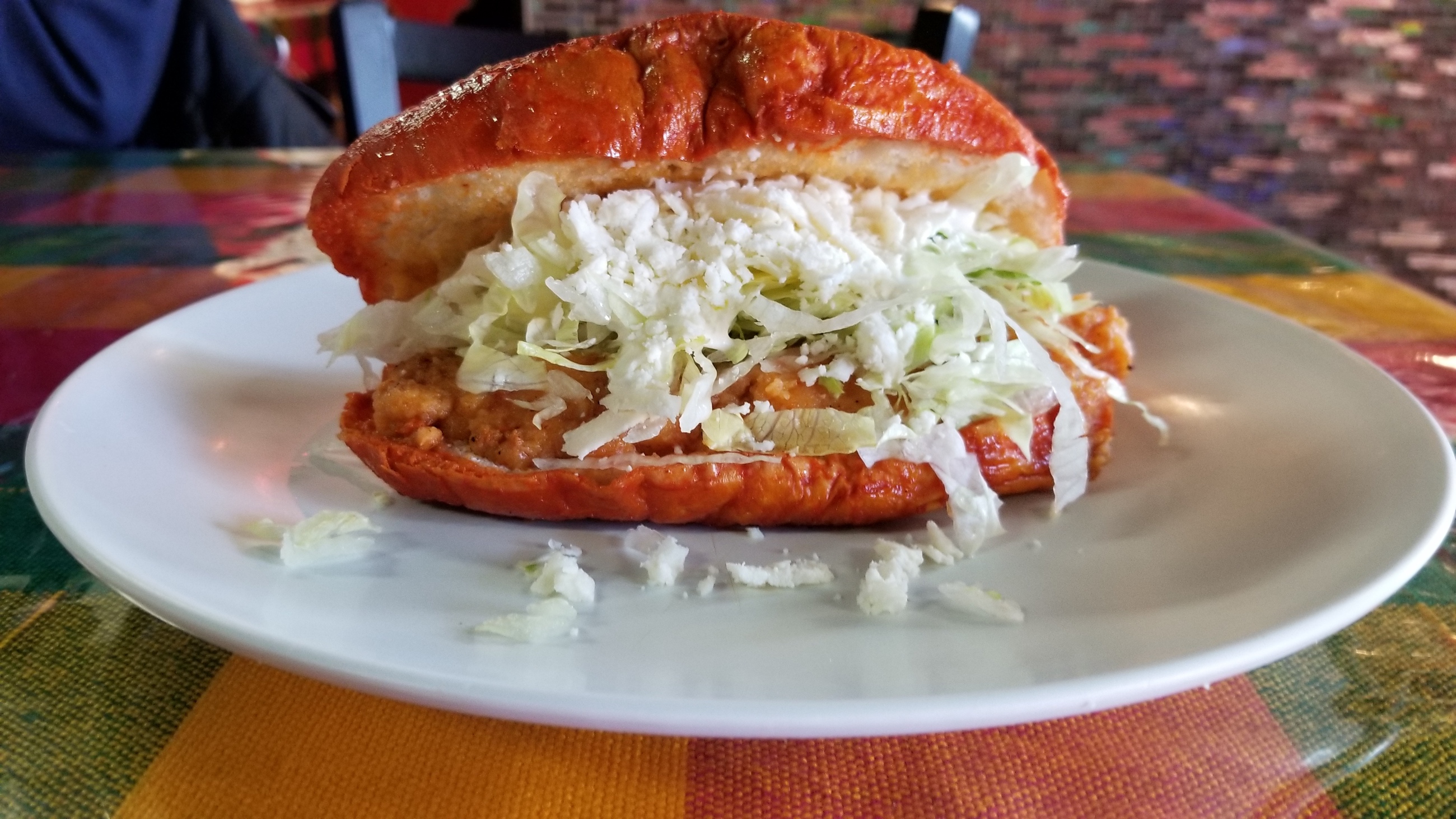“True Viking Grease”–The Danish Bøfsandwich
The Danish bøfsandwich first came to my attention only a couple months ago, courtesy of Chicago Cicerone, beer judge, and Twitter friend Jenny Pfäfflin. She sent me a message one day just to let me know that this thing existed. I hadn’t even heard of it before. This overloaded gravy-doused version of the Danish hamburger has apparently been slowly migrating from its original home in northern Jutland for several decades, only becoming popular in cosmopolitan Copenhagen during the past 8 years.
In that same recent span, a group of Danes has convened to try and rate every bøfsandwich they can find, posting their reviews on Facebook and other social media, and presenting a prize annually for the year’s best bøfsandwich. As JP pointed out to me, they have also published a detailed set of recipes, in English, for recreating one’s own bøfsandwich.
Well if you’re going to gift-wrap a new sandwich for the List like that, the least we can do is take up the challenge! The bøfsandwich as described by “De Brune Riddere” (The Brown Knights, so named after the bøfsandwich signature gravy) describe a number of ingredients the sandwich will require, in the order in which they are to be stacked–i.e., bottom bun, mustard, etc. We need to back up a bit and go chronologically, though.
Pickle #1: Beets
See, there are a few pickles that are needed for their version of the bøfsandwich, and pickles require a little advance preparation. First, there are the pickled beets. Pickled beets, you say? To American ears, that doesn’t sound like a hamburger topping. However, they are commonly used with hamburgers elsewhere in the world, and especially beloved in Australia’s Hamburger with the Lot, as described to us by Tribunal author Crit. The only pickled beets I’ve had previously have been store-bought and unimpressive, so I took a chance and made the De Brune Riddere recipe a few weeks ahead of trying the burger.

They are spectacular. The recipe calls for a lot of sugar, and not a lot, or any salt really. I must admit that I only used about 2/3 of the specified amount of sugar in the brine, adding just a little kosher salt instead. Their recipes call for “wine vinegar” without specifying a particular kind. For this I chose a cabernet wine vinegar, which is pungent and intensely sour, with an an intense aroma that I found reminiscent of some of the better sour beers I’ve had.
Pickle #2: Picalilli
Picalilli is an English condiment, a sort of melange of pickled vegetables and spices that filters the intense Indian pickles they encountered during the British Raj through a palate more in keeping with old-fashioned British tastes. The Danish version described on De Brune Riddere’s site is once again very sweet, but tempered this time by the salt the vegetables take on during a brief fermentation. The primary flavors, besides the sugar vinegar, and pickled vegetables, are the powerful bite of Colman’s English mustard and the earthiness of turmeric. The resulting pickle is bright yellow.

Once again, this is a delightful find. The vegetables are slightly sour and quite salty, while the “sauce” of the pickle–made of white wine vinegar, spices, and sugar, thickened with cornstarch–is both sweet and pungent. It’s a cheese tray or a charcuterie platter or a ploughman’s lunch waiting to happen.
I made the picalilli ahead of time, as with the beets, to allow its flavors to meld before use. Though it isn’t added directly to the bøfsandwich–it’s mixed with mayonnaise to make a remoulade sauce–I’m glad to have it in my pantry.
Pickle #3: Agurkesalat
Agurkesalat has graced these pages before, though I likely misspelled it at that time, and may have gotten the recipe wrong as well. But there are similar quick-pickled cucumber salads in Finnish cuisine as well as Danish, and likely other north European cuisines as well. As a refrigerator pickle or quick pickle, it didn’t need to be made ahead of time. But I did so, canning it and then refrigerating it to keep it fresh and crisp.

Once again I used white wine vinegar in the brine, and once again I cut down on the amount of sugar the recipe called for while adding a little salt. I am not a fan of sweet pickles in general but these are not bad. The family will help me eat them, I’m sure.

Assembling the Bøfsandwich
We start, of course, with the bottom bun. I’m using a soft but sturdy brioche bun, toasted just ahead of time in a pan.

Next up is a brown mustard. I made a special trip this month to Gene’s Sausage Shop where I hoped to find a Danish mustard, or at the very least a German mustard. I didn’t find any Danish mustards, and the German mustards I found were all packaged in faux beer steins. I chose instead a Swedish brown mustard. I hope I have not mortally offended all Danes as a result. Atop the mustard goes a layer of pickled beets.

There are a lot of theories out there about topping burgers, whether to put things below the patty or above. Many people think toppings below the patty help protect the bottom bun from absorbing too much of the meat juices and disintegrating. Wet pickled beets and cucumbers probably aren’t helping there, so I patted them dry before adding.

Raw, diced onions are also added at this point, as is ketchup. Don’t worry, if you forget the ketchup (as I did) you can lift the patty afterwards and add it back in.

Now, the hamburger patty, the star of the show. I used 8 ounces of 80/20 ground chuck, formed into a ball, seasoned, then smashed onto a hot griddle to form a nice crust.

Atop the burger, what the De Brune Riddere site called “soft grilled onions” I call caramelized onions. I spent nearly an hour getting these as sweet and brown as they were here.

Finally, the remoulade. This is a 50/50 mix of homemade mayonnaise with the picalilli described earlier. I contemplated shredding some cabbage into it, as most of the descriptions of Danish remoulade I’ve read mention shredded cabbage. However, the picalilli does contain cauliflower, which is a type of cabbage. Even after pureeing this with an immersion blender, it is still prone to getting stuck in the condiment bottle’s nozzle.

And there you go. We add the top bun and we’ve got a Danish burger.

We don’t yet have this Danish burger though, the bøfsandwich of legend that we’re after, the “true Viking grease” that De Brune Riddere describes.

De Brune Riddere describe the gravy explicitly as brown gravy–it’s even there in their name, and most of the pictures on their site depict a thick deep dark brown liquid–and suggest deglazing the pans where you’ve cooked your onions and your burger with beer to build a pan sauce thickened with cornstarch. Alternatively, they say that pork gravy is a nice contrast, or any old leftover beef gravy will do. For the fancy folks among us, they suggest building the gravy from a sauce bordelaise or sauce espagnole instead.

I think you know where I’m going here. I started my sauce espagnole with a mirepoix, which, once browned, I built into a brown roux before adding veal demiglace, tomato puree, and herbs, then strained into a pyrex measuring cup. After cooking my onions and my burger, I deglazed the pan each time with beer, which I strained and mixed into the sauce espagnole. This became my gravy.

It’s a bit redder than the gravy described by De Brune Riddere. I can live with that. We’re still not done, though. We have yet to add the brilliant touch, the thing that elevates many Danish sandwiches beyond just a stack of tasty things on bread. I don’t know why we don’t do this here in America, but in Denmark, they like to put crispy fried onions–you know, like the kind on top of a green bean casserole at Thanksgiving–on their sandwiches.

This is the bøfsandwich. It’s a mountain of a sandwich, a pile of grease and carbs that may only seem like a good idea under the influence of perhaps a drink or five. To assist me with this simulation, I invited a few of the bøfsandwich countrymen along.

It should come as no surprise that this thing is delicious. There are many delicious things that have gone into building it. But it’s also well-composed. The sweetness and acidity of the pickles help cut the lush umami of the gravy. The pungency of the onion provides a sharp complement to the rich beef burger. The fried onions provide much-needed texture as the gravy begins to disintegrate the bun, and the structured stack of carefully arranged ingredients devolves to chaos.

It is a *lot* of food though. Predictably, after finishing this entire burger, along with several Carlsbergs and a few shots of Akvavit, I succumbed to sleep. The bøfsandwich had beaten me. I still felt like I had won, though.
Bonus Sandwich: The Danish Hot Dog
In JP’s Twitter profile, she refers to herself as a Danish hot dog enthusiast. This, at least, was something I’d heard of before. The Danish hot dog is a long, thin, natural casing forcemeat, often dyed bright red, that is served in a bun with a unique set of toppings, all of which were also used in the bøfsandwich: ketchup, mustard, remoulade, raw diced onions, crispy fried onions, and agurkesalat. It seemed almost criminal to not also try making one of these. However, according to JP, the sausage itself is “nearly impossible” to find in the US.
That is what I have a sausage grinder for, friends.
This recipe, link provided by JP, was poorly translated by Google, but close enough I thought that I could figure out the missing pieces. “Grape sugar” I took to mean corn sugar or dextrose. An emulsion, or forcemeat, some of the sausage contents are processed with ice and water into a slurry, which is then mixed with finely ground meat and seasonings before being stuffed into sheep casings.
I found the sheep casings difficult to work with. It was my first time using them, and they are much skinnier than the hog casings I’m used to, more difficult to rinse and open the ends, more difficult to feed onto the sausage stuffing tube, more prone to tearing. Worst of all was the smell. I have worked with hog casings and beef bung, and nothing else has smelled as much like something that once lived in an animal’s rear end.
I managed to get the sausages stuffed though, and hung to dry, and smoked for an hour over beechwood before simmering for about 15 minutes in water. I bought a new sausage stuffer to use with these sausages, which worked much more quickly than the augur-based stuffer I’d used previously, and I overfilled much of the sausage as a result. Many of them split open in the water.
But some few of them were in decent shape, and even the split ones will taste fine after being grilled or griddled. I picked up a bag of hot dog buns from a grocery store’s bakery section and made my family some lunch, browning the casings of several hot dogs in a pan.

I had twisted the sausages into 10″ or so lengths for the most part, some shorter, a few longer, but consistency of length helps make hanging them in the smoker easier. This one hadn’t split while simmering but did have a small tear in one end that happened during the stuffing process.

As with the bøfsandwich, the hot dog–cured to a pink color but not dyed red, so a pølse if not specifically a rød pølse–is dressed with ketchup, brown mustard, and yellow remoulade.

Similarly to many other varieties of hot dog, diced onions go atop the hot dog, glued in place by the various sauces.

Unlike other hot dogs, once again the brilliant Danish habit of topping things other than casseroles with these delicious fried onions comes into play, making this hot dog style unique.

Finally, a lid of overlapping sweet pickles, the agurkesalat, is placed along the top of the bun.

The Danish hot dog is served at hot dog carts on every corner in Copenhagen, it is said, and it is traditionally, habitually paired with bottled chocolate milk, of which the almost universally-preferred brand is Cocio. Unable to source Cocio, I just grabbed whatever was in the cooler at the supermarket. A well-dressed dog like this is meal enough, but I served it with potato chips as well. I read somewhere that the most popular flavor of potato chips in Denmark is sour cream and onion. Those I can get locally.

My sausages were–not a complete disaster, but I can see ways to improve the process, and if I were to make them again I might go a little lighter on the nutmeg, add some coriander to the spice mix. The combination of the extra-long hot dog with the Danish-style toppings though was definitely a winner. The picalilli-based remoulade is both sweet and pungent, bridging the gap between ketchup and mustard. The raw onions, fried onions, and cucumber salad each bring a slightly different crisp texture, accentuating the snap of the sausage. The sturdy bakery-style bun holds them all together in a way that a mass-produced American hot dog bun wouldn’t. The extra long sausage allows for extra sausage at either end, instead of a blank bite of sauce-laden bun.

It’s a pretty great combination, and I hope I did it justice. The Danish hot dog and the bøfsandwich are both unfamiliar and a little strange to me as an American, using ingredient combinations that are unusual in the US. Yet they seem not only plausible, inevitable combinations even, they also seem very American, in the wild excess they employ. Perhaps that is parochial of me–street foods everywhere celebrate indulgence, burgers and hot dogs especially so. I wouldn’t mind seeing this Danish decadence come a little closer to home. Until there’s a Pølsevogn on my corner though, I’ll just have to work on my rød pølse recipe.

I like sandwiches.
I like a lot of other things too but sandwiches are pretty great











What a pity this hasn’t had more attention for almost ten years. To me as a Dane, who likes hotdogs as well as bøfsandwich, it really looks like you nailed both.
Regarding the red sausages, they are really just “vienna sausages”. (It even seems to have been a viennese sausage maker, John F. Lahmer, who had the idea to dye them red, presumably to make them look more appetising (?) – although there also is a theory that they were dyed to indicate that they were no longer fresh or of poorer quality, and therefore to be sold cheaper.) They are similar to frankfurters, just thinner. I believe the word “wiener” is used as a euphemism or slang for a certain bodypart in the US, so I would have thought you could get them?
As for the bøfsandwich, it may be of interest that before the modern burger chains like Burger King and MacDonalds invaded Denmark around 1980 (!), you could actually get a (usually very poor) kind of burger at many hot dog stands, called a “bøfsandwich”. A small bun, with a dab of mustard, tiny, often poor quality patty, maybe a slice of raw onion, a slice of pickled beet, pickled cucumber, ketchup, remoulade and crisp fried onions. Essentially the same ingredients as the hot dog, and no sauce. I have no idea when they were introduced, but I know that Popeye cartoons and comics were quite popular in Denmark even before WW2 (a weekly comics magazine was published in Denmark between 1938 and 1963), and Popeye’s friend, J. Wellington Wimpy, is often seen devouring mountains of hamburgers, which were in the Danish translation called “bøf sandwich” (literally “beef sandwich”.) Of course both beef and bøf etymologically go back to French “boeuf”, from Latin “bovem”. Currently it seems to be generally assumed that the bøfsandwich was first introduced in Denmark by a restaurant in Dyrehavsbakken in 1949, but I wonder if the presence of it in Popeye cartoons and comics could mean that it had been known – and maybe served – in Denmark earlier than that.
Good lord! This blog is golden. The bøfsandwich is gorgeous. I am going to the market for cucumbers to make this, and black-eyed peas will also make the Senegalese sandwich. I fully appreciate the detailed posts and the ability to access them without dealing with TikTok or IG.